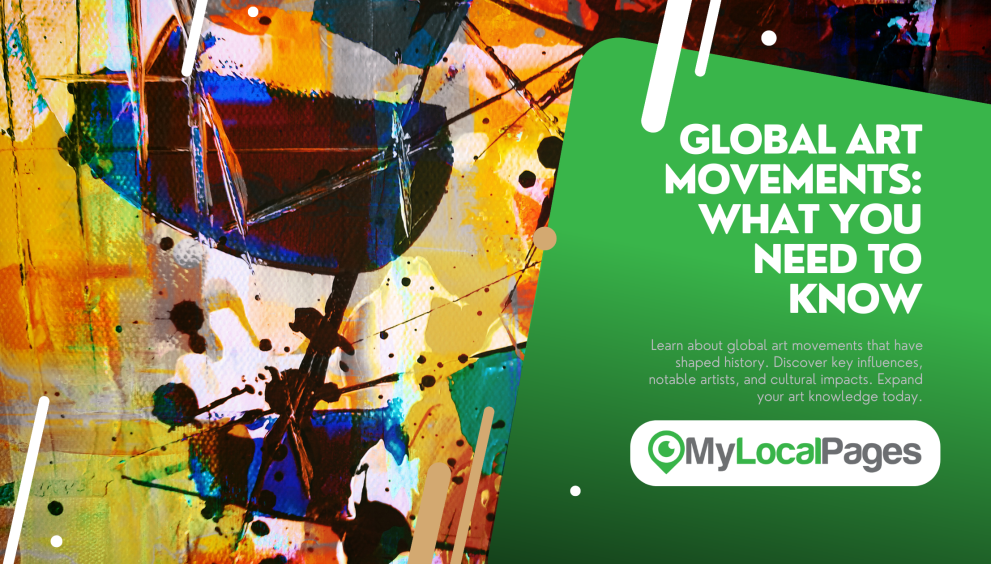Global Art Movements: What You Need to Know

Art, a universal language, transcends borders and cultures. Throughout history, various art movements have emerged, each reflecting the social, political, and intellectual climate of their time. Understanding these movements allows us to appreciate art on a deeper level and gain insights into the human story.
This blog serves as your comprehensive guide to global art movements. We’ll explore key influences, prominent artists, and the lasting cultural impacts of these artistic revolutions. So, whether you’re a seasoned art aficionado or just beginning your artistic journey, this guide will enrich your understanding of the world through the lens of art.
Let’s embark on this exploration!
The Dawn of Modern Art Movements: Breaking the Mold (18th-19th Century)
The 18th and 19th centuries witnessed a significant shift away from traditional artistic styles. Artists began challenging established norms and experimenting with new techniques. Here are some pioneering movements of this era:
- Neoclassicism (1750-1850): Inspired by the ideals of ancient Greece and Rome, Neoclassical artists emphasized order, balance, and harmony. Jacques-Louis David’s “Oath of the Horatii” exemplifies this movement.
Action: Delve deeper into Neoclassical art by exploring the Metropolitan Museum of Art’s online collection.
- Romanticism (1780-1850): A reaction to the Enlightenment’s emphasis on reason, Romanticism celebrated emotion, imagination, and the natural world. Caspar David Friedrich’s “Wanderer above the Sea of Fog” beautifully captures the Romantic spirit.
Action: Want to learn more? Read this insightful article on Romanticism by the Tate museum.
Feeling inspired? Consider contacting My Local Pages to explore how they can help promote your local art gallery or studio! They specialize in getting businesses like yours seen by the right audience.
Stepping into the Modern Era: Experimentation and Innovation (Late 19th-Early 20th Century)
The late 19th and early 20th centuries saw a blossoming of innovative art movements that challenged traditional notions of art.
- Impressionism (1870s-1880s): Impressionists sought to capture the fleeting effects of light and atmosphere. Claude Monet’s “Water Lilies” is a prime example.
Take a virtual tour of the Musée Marmottan Monet in Paris, home to an extensive collection of Impressionist works.
- Post-Impressionism (1880s-1900s): Building on Impressionism, Post-Impressionists used bolder colors and explored form and structure. Vincent van Gogh’s “Starry Night” exemplifies this movement.
Immerse yourself in Van Gogh’s world with the Van Gogh Museum’s online collection.
- Expressionism (Early 20th Century): Expressionists aimed to express emotions and inner experiences through distorted forms and intense colors. Edvard Munch’s “The Scream” is a powerful example.
Action: Learn more about Expressionism’s history and key figures on The Museum of Modern Art’s website.
These movements paved the way for modern art. Are you interested in showcasing your own artistic expression? My Local Pages can help connect you with potential patrons and venues to exhibit your work.
The 20th Century and Beyond: A World of Artistic Diversity
The 20th and 21st centuries have witnessed a rich tapestry of artistic movements, each reflecting the complexities of the modern world.
- Cubism (Early 20th Century): Cubists fragmented objects into geometric shapes, presenting multiple viewpoints on a single canvas. Pablo Picasso’s “Les Demoiselles d’Avignon” is a groundbreaking example.
Explore a curated collection of Cubist works at the Guggenheim.
The 20th Century and Beyond: A World of Artistic Diversity (Continued)
- Surrealism (1920s-1930s): Surrealists tapped into the subconscious mind, creating dreamlike and fantastical imagery. Salvador Dalí’s “The Persistence of Memory” is a recognizable example.
The Salvador Dalí Museum website offers a wealth of information on Surrealism and Dalí’s work.
- Abstract Expressionism (Mid-20th Century): Abstract Expressionists focused on emotional expression through large-scale, abstract compositions. Jackson Pollock’s drip paintings exemplify this movement.
The Smithsonian Institution offers an online resource dedicated to Abstract Expressionism.
- Pop Art (1950s-1960s): Pop Art blurred the lines between high and low culture, incorporating popular imagery and mass media into art. Andy Warhol’s Campbell’s Soup Cans are a prominent example .
Explore the Tate Modern’s collection of Pop Art works.
- Street Art (Late 20th Century-Present): Street art utilizes public spaces as a canvas for social and political commentary. Banksy’s iconic works are a prime example.
My Local Pages can help connect you with local communities and businesses to showcase your work in a public forum.
The Ever-Evolving Landscape of Art
Art movements are not static entities; they influence and inspire each other, creating a dynamic and ever-evolving artistic landscape. As the world continues to change, so too will the art it produces.
Understanding these movements allows us to appreciate the richness and complexity of human experience reflected through art. Whether you’re a seasoned art lover or just beginning your artistic journey, exploring these movements will undoubtedly enrich your understanding and appreciation for the visual world.
Interested in learning more? Here are some additional resources:
- The Metropolitan Museum of Art’s Heilbrunn Timeline of Art History
- The Museum of Modern Art’s Learning Resources
- The National Gallery of Art’s Teaching Resources
Ready to take your love of art to the next level? My Local Pages can help connect you with local galleries, museums, art classes, and events. Let them help you explore the vibrant art scene in your community.











